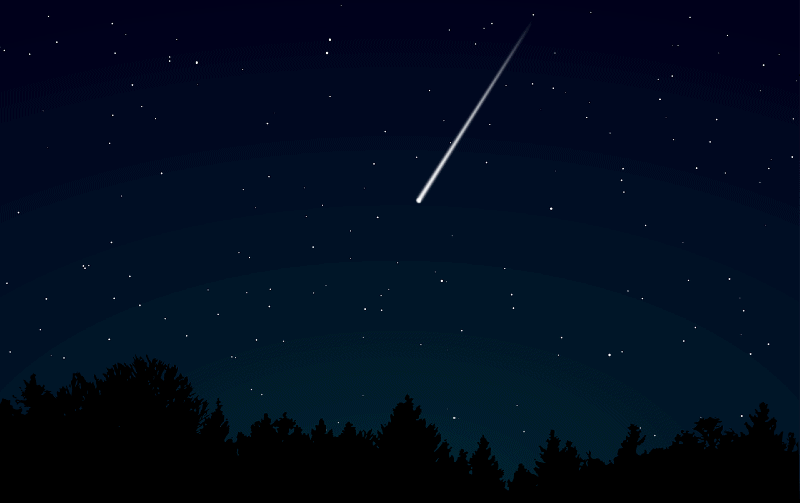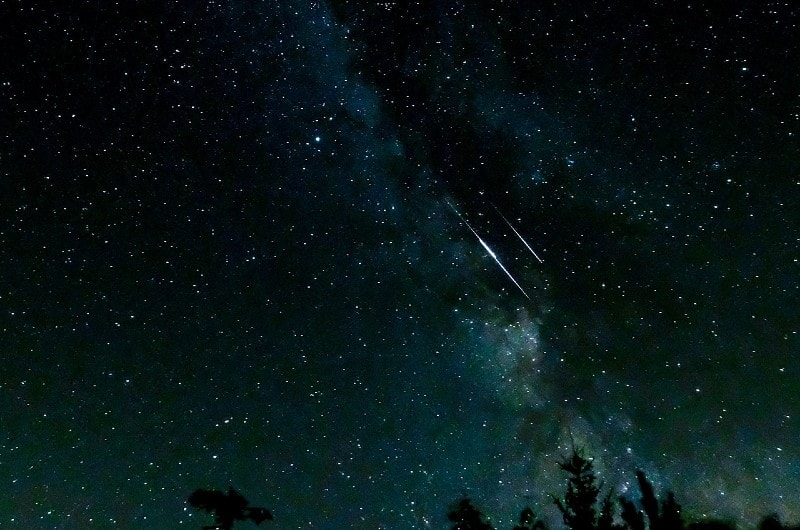What Is a Shooting Star? Understanding It Thoroughly!
Last Updated on

Witnessing a shooting star causes many people to stop and make a wish. However, many people are unsure about the science behind these occurrences. If you want to learn more about shooting stars, keep reading!
The truth is that shooting stars are actually meteors falling through Earth’s atmosphere.

What Is a Shooting Star?
A shooting star is not a star at all — it’s actually a small meteor falling to Earth. As the meteor falls through the atmosphere at high speed, friction with the air molecules causes the rock to heat up, and the high temperature causes the surface to become red hot. If the meteor falls at night, the high surface temperature can make it visible for many miles and be bright enough to resemble the stars in the night sky, which is how it got its name. Most meteors burn up completely before they reach the ground, but some larger meteors can impact the Earth, even causing considerable damage.

What Are the Different Types of Meteors?
Meteoroid
When discussing shooting stars with other people, there’s a good chance that you will hear the term meteoroid. A meteoroid is a meteor before it reaches the ground. Most meteoroids burn up in the atmosphere.
Meteorite
Once a meteoroid hits the ground, it becomes a meteorite. Meteorites are not common, so collecting them is a lucrative hobby for many people. A meteorite can cause significant damage, producing large craters and even setting off catastrophic global events, though this is extremely rare.
Asteroid
Before a meteor enters the Earth’s atmosphere and becomes a meteoroid, it is an asteroid. Asteroids are common in space, and there are many between Jupiter and Mars in an area that scientists call the asteroid belt. The largest asteroid in the asteroid belt is a dwarf planet called Ceres, which is about 590 mi. wide. There are several other large asteroids in the belt, but they aren’t quite as big as Ceres.

C-Type Asteroids
C-type asteroids are the most common and make up about 75% of the known asteroids. The “C” stands for carbon, the primary material in the asteroid, giving it its coal-black surface.
S-Type Asteroids
S-type asteroids are the second most common, making up about 17% of the known asteroids. They are most prominent in the inner asteroid belt and are brighter than C-type asteroids due to nickel-iron mixing with iron and magnesium silicates.
M Type Asteroids
M- type asteroids are mostly metal. Their pure nickel-iron construction causes them to be fairly bright and easy to see, but they are the rarest of the big three, only making up a small percentage of the asteroids that we know of.
Other asteroid types
Besides the three main asteroid types, there are also several rare types, including A-, D-, E-, P-, Q-, and R-type asteroids. While the asteroid belt is quite large, spanning an area of more than 140 million miles across, all the asteroids are far apart, and there’s little danger to any spacecraft passing through it.
Where Are Shooting Stars Found?
Most of the asteroids in the solar system are contained within the asteroid belt between Jupiter and Mars. However, asteroids can exist anywhere in space and even enter from outside the solar system, which is why astronomers are constantly on the lookout for anything headed our way.

Frequently Asked Questions (FAQs)
What causes shooting stars?
Most small meteors that enter our atmosphere quickly burn up, creating a flash of light in the sky.
What are meteorites made of?
Meteorites are primarily stone (silicate), iron, and nickel, though some rarer asteroids can have different elements that can affect how reflective it is.
What color are shooting stars?
Shooting stars can appear in many different colors, including orange, yellow, blue, green, violet, and red. Several things can affect the color that you see, including the meteorite’s chemical makeup, the angle at which it enters the atmosphere, and its overall speed.

How often do shooting stars occur?
Shooting stars can occur at any time, and many small meteoroids enter our atmosphere daily. However, the number of shooting stars can increase when the orbit of Earth passes through the path of a comet, leading to a meteor shower.
Can a shooting star hit the Earth’s surface?
While most meteoroids burn up long before they reach the surface, a larger meteor may be able to get through. There is always a danger that an exceptionally large meteor can set off a cataclysmic event similar to what finished off the dinosaurs.
How do I observe a shooting star?
- If you live in a heavily populated area with excessive amounts of artificial light, you will likely need to travel to an area with less light pollution to get a good view of the sky and any meteors that might enter.
- Try to find out which direction the meteors will come from before you venture outside to look for them.
- Determine what time peak activity will occur when watching a meteor shower so you don’t have to spend much time sitting around without any sightings.
- Use a stargazing app to learn the best times to view a meteor shower. These apps will also help ensure that you’re looking in the right direction.
Why do people make a wish when they see a shooting star?
The desire to wish upon a falling star likely started with Ptolemy, a Greek astronomer, who declared that shooting stars were the gods opening the sky to see what was happening on Earth. Since people believed that the gods were listening, it made sense that they would try to make wishes at these times. The same story explains why many people consider it impolite to point at a shooting star, as it might offend the gods.
Other Meanings for Shooting Stars
The Greeks weren’t the only ones to give meaning to shooting stars. Other cultures link shooting stars to souls; seeing one after a person dies signifies the soul moving on to the next part of existence.
When to See a Shooting Star
| Meteor Showers | When to View |
| Lyrids | April 14th to April 30th |
| Eta Aquarids | April 19th to May 29th |
| Perseids | July 17th to August 24th |
| Orionid | October 2nd to November 7th |
| Leonids | November 6th to November 30th |
| Geminid | December 7th to December 17th |

Final Thoughts
A shooting star is an asteroid that enters Earth’s atmosphere from outer space and becomes a meteoroid. As gravity pulls the meteoroid through the atmosphere, it begins to burn up and produce a bright light. Most meteoroids burn up in the atmosphere, but a few can reach the surface and turn into meteorites. A meteorite can cause significant damage if it’s big enough, but finding a piece of it can be extremely lucrative, and there are many collectors worldwide. If you are just getting into astronomy, the best way to see a shooting star is to travel to an area with dark skies during one of the many yearly meteor showers.
Featured Image Credit: OpenClipart-Vectors, Pixabay
About the Author Ed Malaker
Ed Malaker is a veteran writer who contributes to a wide range of blogs covering information on computer programming, pets, birding, tools, fitness, guitars, and optics. Outside of writing, Ed is often found working in the garden or performing DIY projects in the house. Ed is also a musician, spending his time composing music for independent films or helping people repair their guitars.
Related Articles:
What Is the Best Binocular Magnification for Hunting? Optical Features Explained
15 Crucial Facts About Ultraviolet Rays & the Sun
What Constellation Is Spica In? The Interesting Answer!
10 Interesting Leo Constellation Facts, Myths, and FAQs
15 Interesting Pegasus Constellation Facts, Myths, and FAQs
6 Interesting Sagittarius Constellation Facts, Myths, and FAQs in 2024!
What Are Constellations? Where Did They Come From?
8 Interesting Libra Constellation Facts, Myths, and FAQs
